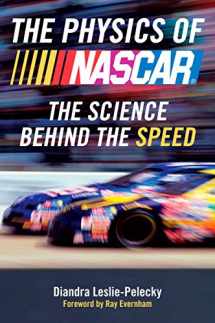
The Physics of Nascar: The Science Behind the Speed
ISBN-13:
9780452290228
ISBN-10:
0452290228
Edition:
Reprint
Author:
Diandra Leslie-Pelecky
Publication date:
2009
Publisher:
Plume
Format:
Paperback
300 pages
Category:
Automotive
,
Automotive
,
Engineering
,
Applied
,
Physics
,
Technology
,
Journalism
,
Sports Miscellaneous
,
Motor Sports
,
Transportation
FREE US shipping
Book details
ISBN-13:
9780452290228
ISBN-10:
0452290228
Edition:
Reprint
Author:
Diandra Leslie-Pelecky
Publication date:
2009
Publisher:
Plume
Format:
Paperback
300 pages
Category:
Automotive
,
Automotive
,
Engineering
,
Applied
,
Physics
,
Technology
,
Journalism
,
Sports Miscellaneous
,
Motor Sports
,
Transportation
Summary
The Physics of Nascar: The Science Behind the Speed (ISBN-13: 9780452290228 and ISBN-10: 0452290228), written by authors
Diandra Leslie-Pelecky, was published by Plume in 2009.
With an overall rating of 3.6 stars, it's a notable title among other
Automotive
(Automotive, Engineering, Applied, Physics, Technology, Journalism, Sports Miscellaneous, Motor Sports, Transportation) books. You can easily purchase or rent The Physics of Nascar: The Science Behind the Speed (Paperback) from BooksRun,
along with many other new and used
Automotive
books
and textbooks.
And, if you're looking to sell your copy, our current buyback offer is $0.65.
Description
A physicist explores the science of speed racing and the #1 spectator sport in America in the perfect gift for both NASCAR and science fans.
Every NASCAR fan—at one time or another—asks the same question: Why isn’t my favorite driver winning? This is your chance to discover how much more there is to NASCAR than “Go fast, turn left and don’t crash.” If you’ve ever wondered why racecars don’t have mufflers, how “bump drafting” works, or what in the world “Let’s go up a pound on the right rear and add half a round of wedge” means, The Physics of NASCAR is for you.
In this fast-paced investigation into the adrenaline-pumping world of NASCAR, a physicist with a passion uncovers what happens when the rubber hits the road and 800-horsepower vehicles compete at 190 miles per hour only inches from one another.
Diandra Leslie-Pelecky tells her story in terms anyone who drives a car—and maybe occasionally looks under the hood--can understand. How do drivers walk away from serious crashes? How can two cars travel faster together than either car can on its own? How do you dress for a 1800°F gasoline fire? In simple yet detailed, high-octane prose, this is the ultimate thrill ride for armchair speed demons, auto science buffs, and NASCAR fans at every level of interest.
Readers, start your engines.
Every NASCAR fan—at one time or another—asks the same question: Why isn’t my favorite driver winning? This is your chance to discover how much more there is to NASCAR than “Go fast, turn left and don’t crash.” If you’ve ever wondered why racecars don’t have mufflers, how “bump drafting” works, or what in the world “Let’s go up a pound on the right rear and add half a round of wedge” means, The Physics of NASCAR is for you.
In this fast-paced investigation into the adrenaline-pumping world of NASCAR, a physicist with a passion uncovers what happens when the rubber hits the road and 800-horsepower vehicles compete at 190 miles per hour only inches from one another.
Diandra Leslie-Pelecky tells her story in terms anyone who drives a car—and maybe occasionally looks under the hood--can understand. How do drivers walk away from serious crashes? How can two cars travel faster together than either car can on its own? How do you dress for a 1800°F gasoline fire? In simple yet detailed, high-octane prose, this is the ultimate thrill ride for armchair speed demons, auto science buffs, and NASCAR fans at every level of interest.
Readers, start your engines.


We would LOVE it if you could help us and other readers by reviewing the book
Book review

Congratulations! We have received your book review.
{user}
{createdAt}
by {truncated_author}



